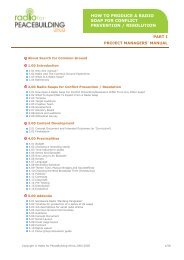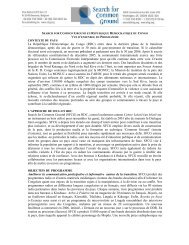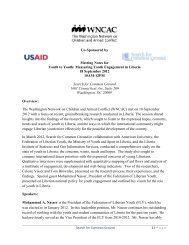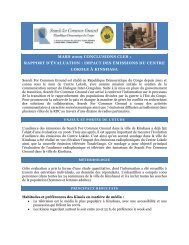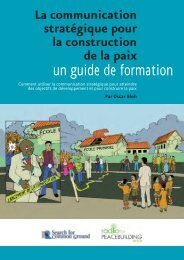The Common Ground Network for Life and Choice Manual
The Common Ground Network for Life and Choice Manual
The Common Ground Network for Life and Choice Manual
You also want an ePaper? Increase the reach of your titles
YUMPU automatically turns print PDFs into web optimized ePapers that Google loves.
Appendix 1.1<br />
THE COMMON GROUND DIALOGUE PROCESS:<br />
A SUMMARY<br />
GROUND RULES FOR DIALOGUE<br />
1. Act, speak <strong>and</strong> listen respectfully.<br />
2. Listen to seek underst<strong>and</strong>ing, not necessarily agreement.<br />
3. Speak <strong>for</strong> yourself.<br />
4. Offer <strong>and</strong> accept views without attempting to convert or convince.<br />
5. Observe confidentiality.<br />
6.Anyone has the option to "pass" without comment/ explanation/ negative connotation.<br />
COMMON GROUND CONCEPTS<br />
Dialogue not Debate.<br />
<strong>The</strong> practice of dialogue lies at the heart of the common ground approach. Dialogue is different from<br />
debate. Debate is about persuading others that your views are “right” <strong>and</strong> that the views of others are “wrong.”<br />
Dialogue is a gentler, more respectful process. <strong>The</strong> spirit of dialogue is to acknowledge <strong>and</strong> honor the humanity of<br />
all persons present regardless of their points of view. <strong>The</strong> goals of dialogue center around increasing underst<strong>and</strong>ing<br />
<strong>and</strong> being understood rather than persuading others <strong>and</strong> being “right.” When dialogue is attempted in a sustained<br />
<strong>and</strong> polarized conflict, a primary goal is to change the relationship between those who see each other as demonized<br />
adversaries. A carefully constructed dialogue process can enable hard issues to be addressed without leading to bad<br />
feelings.<br />
Searching <strong>for</strong> what is genuinely shared.<br />
<strong>The</strong> idea of common ground can be illustrated by two interlocking circles:<br />
Each circle represents a point of view about abortion (one circle, pro-life; the other, pro-choice). A common ground<br />
process recognizes the integrity of each circle as a complete set of concerns, beliefs <strong>and</strong> values around this issue. A<br />
common ground process primarily focuses attention on <strong>and</strong> explores the area of intersection. Through the search<br />
<strong>for</strong> concerns, beliefs <strong>and</strong> values that are shared, a plat<strong>for</strong>m of underst<strong>and</strong>ing is built. At the same time, when<br />
participants st<strong>and</strong> together in the area of genuine intersection, they can also look at their differences with fresh eyes.



